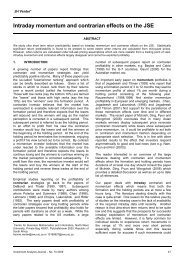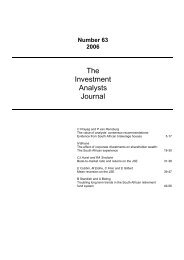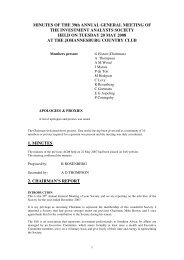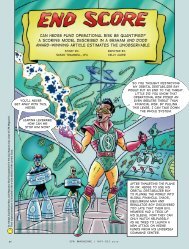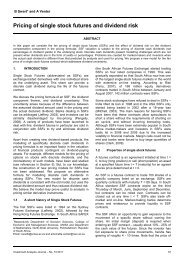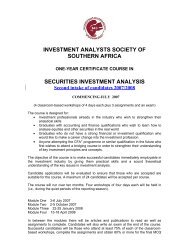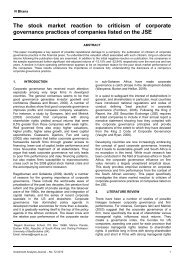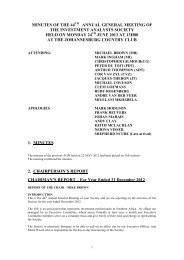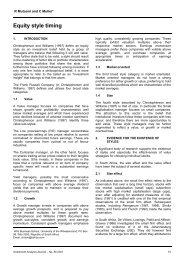The market reaction to capital expenditure announcements
The market reaction to capital expenditure announcements
The market reaction to capital expenditure announcements
Create successful ePaper yourself
Turn your PDF publications into a flip-book with our unique Google optimized e-Paper software.
<strong>The</strong> <strong>market</strong> <strong>reaction</strong> <strong>to</strong> <strong>capital</strong> <strong>expenditure</strong> <strong>announcements</strong><br />
some extent, on the relationship between the project and<br />
the existing operations of the firm.<br />
4. SAMPLE SELECTION AND RESEARCH<br />
METHODOLOGY<br />
4.1 Sample selection<br />
<strong>The</strong> sample consists of all <strong>capital</strong> <strong>expenditure</strong><br />
<strong>announcements</strong> made by companies listed on the JSE<br />
during the period 1 January 1995 <strong>to</strong> 31 December 2004.<br />
To be included in the final sample, the <strong>announcements</strong><br />
had <strong>to</strong> meet the following criteria:<br />
1. <strong>The</strong> announcing company must have its daily share<br />
price data available for the full 120-day estimation<br />
period and also the 21-day period covering the<br />
event study.<br />
2. Announcements must contain definite plans rather<br />
than conjectures about the future investments.<br />
Furthermore, <strong>announcements</strong> must include<br />
information about the approximate size and the<br />
actual use of funds.<br />
3. <strong>The</strong> company must not have any other<br />
announcement during the 10 days before and 10<br />
days after the <strong>capital</strong> <strong>expenditure</strong> announcement.<br />
A <strong>to</strong>tal of 378 <strong>capital</strong> <strong>expenditure</strong> <strong>announcements</strong> met<br />
the criteria and were included in the final sample. <strong>The</strong><br />
data related <strong>to</strong> the <strong>announcements</strong> were obtained from<br />
Reuters News, which provided selected news services<br />
s<strong>to</strong>ries from Business Day and other financial<br />
publications. This publication was used <strong>to</strong> identify news<br />
related <strong>to</strong> the <strong>capital</strong> <strong>expenditure</strong> <strong>announcements</strong> during<br />
the period of the investigation. <strong>The</strong> <strong>announcements</strong> were<br />
confirmed from Business Day and the database of JSE<br />
SENS, which commenced providing company specific<br />
<strong>announcements</strong> by listed companies from March 1998.<br />
<strong>The</strong> data required from the financial statements of<br />
companies included in the sample and the JSE All Share<br />
Index were obtained from the McGregor‟s BFANet<br />
database. All financial data required <strong>to</strong> perform the OLS<br />
regression were also obtained from these sources.<br />
It has been shown that shareholders prefer the concept<br />
of „pure plays” and single-minded focus and that the<br />
<strong>market</strong> reward companies that meet these criteria<br />
(Gadad and Thomas, 2005). Chen (2006) showed that<br />
for companies listed on the NYSE, the <strong>market</strong> <strong>reaction</strong> <strong>to</strong><br />
<strong>capital</strong> <strong>expenditure</strong> <strong>announcements</strong> are more favourable<br />
for focused companies than for diversified companies.<br />
<strong>The</strong>refore, it was decided <strong>to</strong> test if a similar trend exists<br />
for companies listed on the JSE. <strong>The</strong> methodology used<br />
by Chen (2006: 343) <strong>to</strong> measure company focus is used<br />
for this South African study. <strong>The</strong> basic concept is that<br />
the more concentrated the firm‟s sales/assets within a<br />
few (many) of its business segments the more focused<br />
(diversified) are its operations.<br />
<strong>The</strong> financial statements of all companies associated<br />
with <strong>capital</strong> <strong>expenditure</strong> <strong>announcements</strong> were<br />
investigated <strong>to</strong> determine the number of clearly defined<br />
industries and segments in which they operated.<br />
Companies operating in a single segment were<br />
classified as focused companies and those operating in<br />
multiple segments were classified as diversified<br />
companies. <strong>The</strong> final sample comprises 378 <strong>capital</strong><br />
<strong>expenditure</strong> <strong>announcements</strong>: 123 by focused companies<br />
and 255 by diversified companies.<br />
4.2 Research methodology<br />
<strong>The</strong> event study methodology developed by Brown and<br />
Warner (1985) was used <strong>to</strong> determine the excess<br />
returns around the announcement day. An estimation<br />
period from day –180 <strong>to</strong> day –11 is used <strong>to</strong> calculate the<br />
parameters, A i and B i of the following <strong>market</strong> model:<br />
R it = A i + B i R mt + E it … (1)<br />
Where R it is the rate of return of the <strong>capital</strong> investment<br />
company i on day t. R mt is the rate of return on the<br />
<strong>market</strong> portfolio represented by the JSE All Share Index<br />
on day t. B i is the estimated <strong>market</strong> risk of share i. A i is<br />
the estimated intercept. E it is the error term on day t; E<br />
(E it ) = 0. <strong>The</strong> estimated parameters, B i and A i are used<br />
<strong>to</strong> calculate the excess returns, E it from day –10 <strong>to</strong> day<br />
10 for each share as follows:<br />
E it = R it – A i – B i R mt … (2)<br />
To test the statistical significance of these excess<br />
returns, we calculate the following statistics:<br />
n<br />
1<br />
AR t = Eit<br />
… (3)<br />
n <br />
i 1<br />
D<br />
CAR = ARt<br />
… (4)<br />
where:<br />
tD<br />
AR t is the average excess return of all <strong>capital</strong><br />
<strong>expenditure</strong> announcing companies on a given day t;<br />
CAR is the cumulative average excess returns from day<br />
–D <strong>to</strong> day D, and N is the number of companies.<br />
<strong>The</strong> method employed by Dimson (1979) and refined by<br />
Cohen, Hawawini, Maier, Schwartz and Whitcomb<br />
56 Investment Analysts Journal – No. 68 2008




